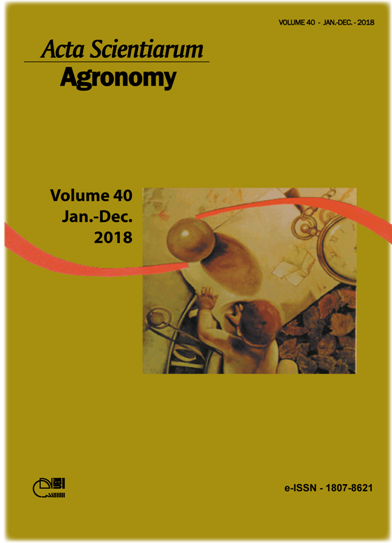<b>Phytosociology of weed in the southwestern Goiás region
Resumo
Roundup Ready® technology adoption and the cultivation of a second crop have changed chemical control methods and weed management in the southwest region of Goiás State, Brazil. Considering these changes, this study aimed to perform a phytosociological survey in areas with glyphosate resistant soybeans and conventional soybeans as the main harvest and sorghum, maize, millet or fallow in succession as the second harvest. A multivariate matrix of the floristic composition was constructed, and the indicator values of the individual number and dry biomass of species were measured. Based on the number of individuals, the species Chamaesyce hirta, Bidens subalternans, and Cissampelos ovolifolia were typical of areas cultivated with glyphosate-resistant soybean, while Euphorbia heterophyla presented indicator values of areas with conventional soybean cultivation. During the second harvest period, significant indicator values were observed for Crotalaria spectabilis in maize areas, Cenchrus echinatus in sorghum, and Commelina benghalensis, Sida glaziovii, Ipomoea grandifolia, Sida rhombifolia, and Ipomoea cordifolia in areas with millet. The species Conyza bonariensis was typical in the period before the herbicide application at post-emergence in harvest. Volunteer soybean presented as typical for the period before the herbicide application at post-emergence in the second harvest. Weeds that were difficult to control or were tolerant and resistant to the herbicide applications were recorded in the areas studied.
Downloads
DECLARAÇÃO DE ORIGINALIDADE E DIREITOS AUTORAIS
Declaro que o presente artigo é original, não tendo sido submetido à publicação em qualquer outro periódico nacional ou internacional, quer seja em parte ou em sua totalidade.
Os direitos autorais pertencem exclusivamente aos autores. Os direitos de licenciamento utilizados pelo periódico é a licença Creative Commons Attribution 4.0 (CC BY 4.0): são permitidos o compartilhamento (cópia e distribuição do material em qualqer meio ou formato) e adaptação (remix, transformação e criação de material a partir do conteúdo assim licenciado para quaisquer fins, inclusive comerciais.
Recomenda-se a leitura desse link para maiores informações sobre o tema: fornecimento de créditos e referências de forma correta, entre outros detalhes cruciais para uso adequado do material licenciado.




















































